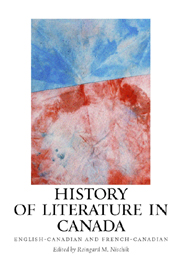Book contents
- Frontmatter
- Contents
- Acknowledgments
- Introduction: Writing a History of Literature in Canada
- I Beginnings
- II The Literature of New France, 1604–1760
- III The Literature of British Canada, 1763–1867
- 6 Historical Overview
- 7 English-Canadian Colonial Literature
- 8 French-Canadian Colonial Literature under the Union Jack
- IV From the Dominion to the Territorial Completion of the Nation, 1867–1918
- V The Modern Period, 1918–1967
- VI Literature from 1967 to the Present
- Further Reading
- Notes on the Contributors
- Index
7 - English-Canadian Colonial Literature
from III - The Literature of British Canada, 1763–1867
Published online by Cambridge University Press: 12 September 2012
- Frontmatter
- Contents
- Acknowledgments
- Introduction: Writing a History of Literature in Canada
- I Beginnings
- II The Literature of New France, 1604–1760
- III The Literature of British Canada, 1763–1867
- 6 Historical Overview
- 7 English-Canadian Colonial Literature
- 8 French-Canadian Colonial Literature under the Union Jack
- IV From the Dominion to the Territorial Completion of the Nation, 1867–1918
- V The Modern Period, 1918–1967
- VI Literature from 1967 to the Present
- Further Reading
- Notes on the Contributors
- Index
Summary
Exploration Narratives and Settler Accounts from Central and Western Canada
IN HIS “CONCLUSION” TO THE Literary History of Canada (1965), Northrop Frye graphically imagines early travelers from Europe edging into Canada like tiny Jonahs “entering an inconceivably large whale,” only to be swallowed by “an alien continent.” The surrounding frontier, adds Frye, was vast and “unthinking,” inevitably shaping the imaginations of those who encountered it. As such, the wilderness awaited mapping, a process that began along an east-west axis in the early days of Canada's social and economic development, but also included longitudinal pulls to the south. The body of Canadian literature that has emerged from this intersection of exploration, settlement, and development, notes Frye, not only “records what the Canadian imagination has reacted to” but also “tells us things about our environment that nothing else will tell us” (in Klinck 1965, 822–31).
As early as the seventeenth century, trader-explorers such as Henry Kelsey (ca. 1667–1724), working for the Hudson's Bay Company (HBC; founded 1670), began to develop scientific observations, daily logs, maps, and journals that would bring definition to Frye's “frontier” or “environment” even as they expanded the fur trade. As the first European to see the Canadian prairies and to witness an Indian buffalo hunt, Kelsey was unique in writing a preface in a poetic style to his 1693 journal, describing his journey down the Hayes River, his naming of places (“this neck of land I deerings point did call”), and his identification of flora and fauna (“Which hither part is very thick of wood / Affords small nutts with little cherryes very good”; Canadian Poetry from the Beginnings, 22–24).
- Type
- Chapter
- Information
- History of Literature in CanadaEnglish-Canadian and French-Canadian, pp. 72 - 87Publisher: Boydell & BrewerPrint publication year: 2008

